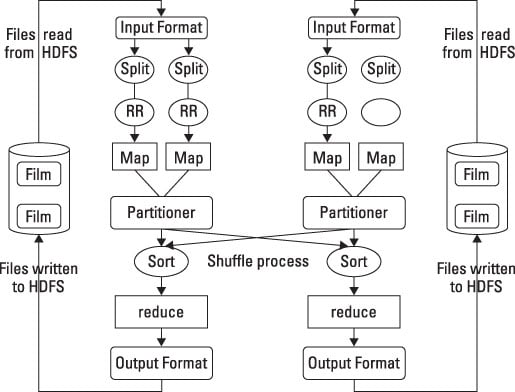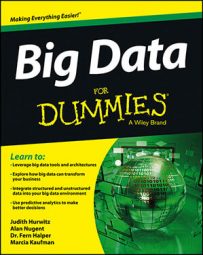To fully understand the capabilities of Hadoop MapReduce, it’s important to differentiate between MapReduce (the algorithm) and an implementation of MapReduce. Hadoop MapReduce is an implementation of the algorithm developed and maintained by the Apache Hadoop project.
It is helpful to think about this implementation as a MapReduce engine, because that is exactly how it works. You provide input (fuel), the engine converts the input into output quickly and efficiently, and you get the answers you need.
Hadoop MapReduce includes several stages, each with an important set of operations helping to get to your goal of getting the answers you need from big data. The process starts with a user request to run a MapReduce program and continues until the results are written back to the HDFS.

HDFS and MapReduce perform their work on nodes in a cluster hosted on racks of commodity servers. To simplify the discussion, the diagram shows only two nodes.
Get the big data ready
When a client requests a MapReduce program to run, the first step is to locate and read the input file containing the raw data. The file format is completely arbitrary, but the data must be converted to something the program can process. This is the function of InputFormat and RecordReader. InputFormat decides how the file is going to be broken into smaller pieces for processing using a function called InputSplit.
It then assigns a RecordReader to transform the raw data for processing by the map. Several types of RecordReaders are supplied with Hadoop, offering a wide variety of conversion options. This feature is one of the ways that Hadoop manages the huge variety of data types found in big data problems.
Let the big data map begin
Your data is now in a form acceptable to map. For each input pair, a distinct instance of map is called to process the data. But what does it do with the processed output, and how can you keep track of them?
Map has two additional capabilities to address the questions. Because map and reduce need to work together to process your data, the program needs to collect the output from the independent mappers and pass it to the reducers. This task is performed by an OutputCollector. A Reporter function also provides information gathered from map tasks so that you know when or if the map tasks are complete.
All this work is being performed on multiple nodes in the Hadoop cluster simultaneously. You may have cases where the output from certain mapping processes needs to be accumulated before the reducers can begin. Or, some of the intermediate results may need to be processed before reduction.
In addition, some of this output may be on a node different from the node where the reducers for that specific output will run. The gathering and shuffling of intermediate results are performed by a partitioner and a sort. The map tasks will deliver the results to a specific partition as inputs to the reduce tasks.
After all the map tasks are complete, the intermediate results are gathered in the partition and a shuffling occurs, sorting the output for optimal processing by reduce.
Reduce and combine for big data
For each output pair, reduce is called to perform its task. In similar fashion to map, reduce gathers its output while all the tasks are processing. Reduce can’t begin until all the mapping is done. The output of reduce is also a key and a value. While this is necessary for reduce to do its work, it may not be the most effective output format for your application.
Hadoop provides an OutputFormat feature, and it works very much like InputFormat. OutputFormat takes the key-value pair and organizes the output for writing to HDFS. The last task is to actually write the data to HDFS. This is performed by RecordWriter, and it performs similarly to RecordReader except in reverse. It takes the OutputFormat data and writes it to HDFS in the form necessary for the requirements of the program.
The coordination of all these activities was managed in earlier versions of Hadoop by a job scheduler. This scheduler was rudimentary, and as the mix of jobs changed and grew, it was clear that a different approach was necessary. The primary deficiency in the old scheduler was the lack of resource management. The latest version of Hadoop has this new capability.
Hadoop MapReduce is the heart of the Hadoop system. It provides all the capabilities you need to break big data into manageable chunks, process the data in parallel on your distributed cluster, and then make the data available for user consumption or additional processing. And it does all this work in a highly resilient, fault-tolerant manner. This is just the beginning.

